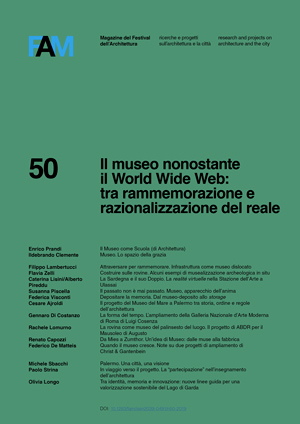Pubblicato 2020-03-25
Parole chiave
- Memoria/memory,
- Deposito/storage,
- Louis I. Kahn,
- Peter Greenaway
Come citare
Abstract
Il testo intende analizzare l’idea di museo come deposito proposta da Louis Kahn nel progetto non realizzato per la de Menil Foundation in Texas, preceduta dalle realizzazioni per la Yale University nel Connecticut e del Kimbell Art Museum a Fort Worth. Analizzando il significato etimologico della parola ‘deposito’ come atto o luogo per la conservazione e la trasmissione della memoria si vuole stabilire un ponte con alcuni fenomeni del contemporaneo nell’epoca del World Wide Web e, in particolare, con l’opera di musealizzazione dell’architettura e della città proposta dal regista britannico Peter Greenaway per interrogarsi infine, anche nell’epoca del digitale, sulla necessità dello spazio per la rappresentazione dei valori di una comunità.
The paper aims to analyse the idea of ‘museum as storage’ proposed by Louis Kahn in the unbuilt project for the de Menil Foundation in Texas preceded by the constructions for Yale University in Connecticut and of the Kimbell Art Museum in Fort Worth. By analysing the etymological meaning of the word ‘storage’ (in Italian, deposito) as the act or the place for preservation and transmission of the memory, a link is established with some contemporary phenomena in the era of the World Wide Web and, in particular, with the work of musealization of architecture and the city proposed by the British director Peter Greenaway, in order to finally question, also in the digital age, the need of the space for the representation of the values of a community.
Riferimenti bibliografici
- BARICCO A. (2018) – The Game, Einaudi, Torino.
- BOULLÉE E.-L. (1967) – Architettura. Saggio sull’arte, Marsilio, Padova.
- BROWNLEE D.B., DE LONG D. (1991) – Louis I. Kahn. In the Realm of Architecture, Rizzoli International, New York.
- CUMMINGS LOUD P. (1991) – Louis I. Kahn. I musei, Electa, Milano.
- DAL CO F. (2014) – “Renzo Piano. The Menil Coolection”. https://www.doppiozero.com/materiali/architettura/renzo-piano-menil-collection.
- DI PETTA R. (2010) – Louis Isadore Kahn. La misura dell’eterno, Aracne, Roma.
- FERRARIS M. (2012) – Documentalità. Perché è necessario lasciar tracce, Laterza, Bari.
- FINESSI B., MENEGUZZO M. (2007) – Bruno Munari, Silvana Editoriale, Cinisello Balsamo (MI).
- GREENAWAY P. (2010) – L’Italia delle città / Italy of the Cities / 城意大利, Skira, Milano.
- GUBLER J. (1985) – “La campata è un tipo?”. Casabella, 509-510.
- HALBWACHS M. (1987) – La memoria collettiva, Unicopli, Milano.
- KAHN L.I. (1965) – “Remarks”. Perspecta, 9/10.
- KAHN L.I. (1967) – “Statement on Architecture”. Zodiac, 17.
- KAHN L.I. (1969) – “Talks with students”. Architecture at Rice, 26.
- KAHN L.I. (1972) – “The Invisible City. International Design Conference in Aspen”. Architecture at Rice, 26. In: WURMAN R.S. (ed.) (1986) – What Will Be Has Always Been: The Words of Louis I. Kahn, Access and Rizzoli, New York.
- SCOTT BROWN D. (1984) – “A Worm’s Eye View of Recent Architectural History”. Architectural Record,172.
- SCHRÖDER U. (2019) – “Sullo spazio sacro”. In VISCONTI F. – Aule sacre. Edifici di culto per la ri-composizione urbana di Barra, Aracne, Canterano (RM).
- VISCONTI F., CAPOZZI R. (2019) – Kahn e Mies. Tre modi dell’abitare, Clean, Napoli.
- WURMAN R.S. (ed.) (1986) – What Will Be Has Always Been: The Words of Louis I. Kahn, Access and Rizzoli, New York.

